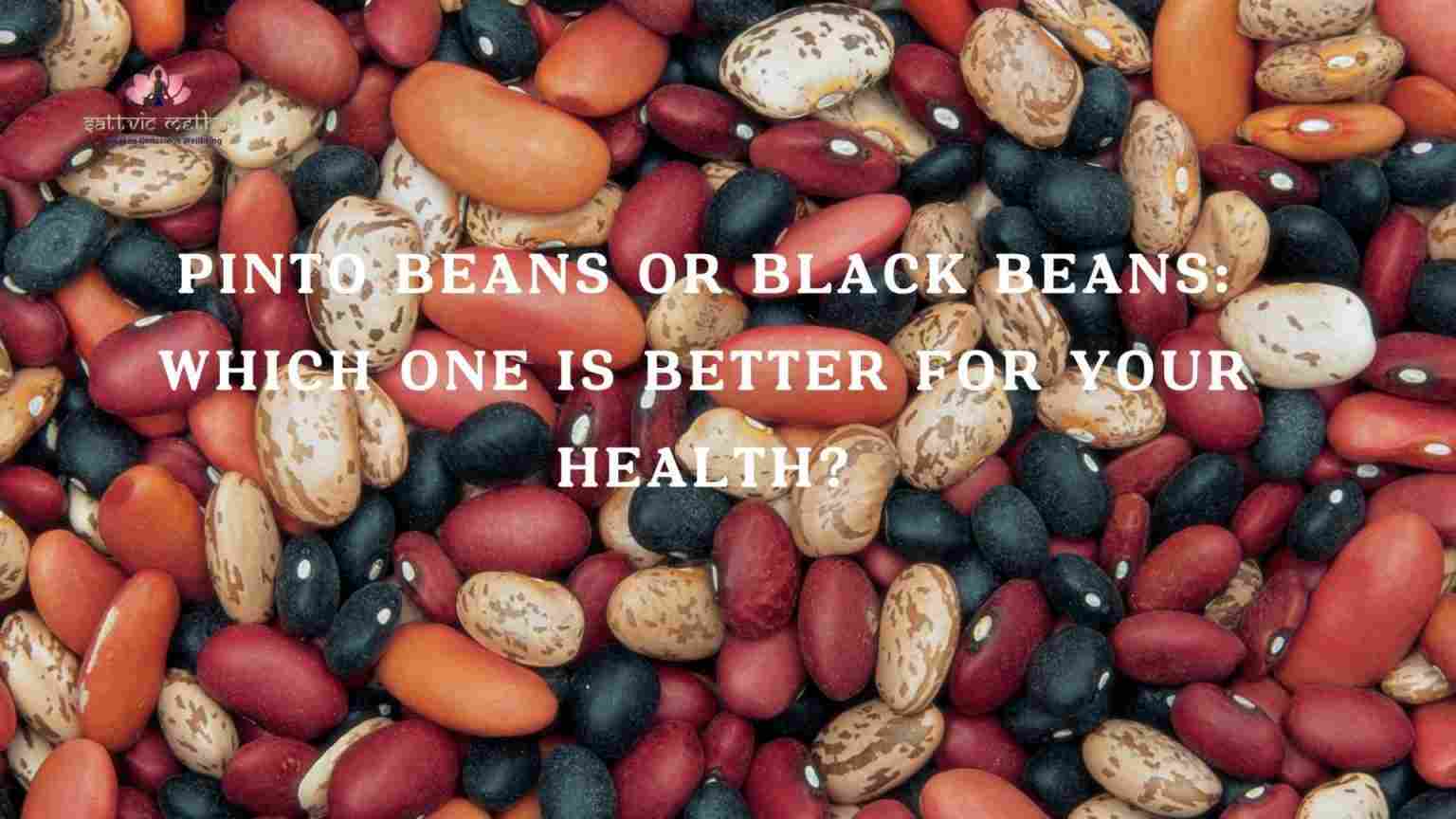In the ultimate battle of legumes, two contenders step into the ring: black beans and pinto beans. Both boast impressive nutritional profiles and versatile culinary uses, but which one will be crowned the supreme champion of health?
Black beans, known for their rich, meaty flavor and velvety texture, pack a punch when it comes to nutrition. Packed with protein, fiber, and a variety of vitamins and minerals, they are a staple in many Latin American and Caribbean cuisines. But will their impressive resume be enough to claim victory?
On the other side of the ring, we have pinto beans. These speckled beauties are beloved for their creamy texture and earthy taste. Like their black counterparts, pinto beans are brimming with protein, fiber, and essential nutrients, making them a go-to choice for many health-conscious individuals.
So, who reigns supreme in this health showdown? Join us as we dive deep into the nutritional profiles, health benefits, and culinary uses of black beans and pinto beans to determine the ultimate winner in the battle of the beans. Get ready for an epic showdown that will satisfy both your taste buds and your quest for optimal health.
Nutritional Comparison Between Black Beans and Pinto Beans
When it comes to nutrition, both black beans and pinto beans are powerhouses packed with essential nutrients. On a per-cup basis, black beans contain about 227 calories, while pinto beans clock in at approximately 245 calories. Despite the slight difference in calorie content, both types of beans are low in fat and high in protein, making them excellent sources of plant-based nutrition. Black beans provide about 15.24 grams of protein per cup, while pinto beans offer around 12.36 grams. This protein content is particularly beneficial for vegetarians and vegans looking to meet their protein needs without relying on animal products.
Both beans are rich in dietary fiber, which plays a crucial role in digestive health. Black beans contain about 15 grams of fiber per cup, while pinto beans provide around 13 grams. Fiber is essential for maintaining a healthy digestive system and can help regulate blood sugar levels, making both beans a smart choice for those managing diabetes. Additionally, the high fiber content in both black and pinto beans can aid in weight management by promoting a feeling of fullness, which can help reduce overall calorie intake.
In terms of micronutrients, both varieties shine as well. Black beans are particularly high in folate, providing about 64% of the daily recommended intake per cup. They also contain significant amounts of iron, magnesium, and potassium. Pinto beans are not to be outdone, as they also offer a good amount of folate, as well as phosphorus and B vitamins. Ultimately, while there are slight variances in their nutritional profiles, both black beans and pinto beans offer substantial health benefits and can be excellent additions to a balanced diet.
Health Benefits of Black Beans
The health benefits of black beans are vast and well-supported by research. Rich in antioxidants, particularly anthocyanins, black beans contribute to reducing oxidative stress in the body. Oxidative stress is linked to numerous chronic diseases, including heart disease and cancer. By consuming black beans regularly, you may enhance your body’s ability to combat free radicals, thereby improving overall health and longevity.
Another significant benefit of black beans is their role in heart health. The fiber, potassium, and magnesium content in black beans can help regulate blood pressure and cholesterol levels. Studies have shown that diets high in fiber can lead to lower LDL cholesterol levels, which is crucial for heart health. Regular consumption of black beans may also help reduce the risk of developing cardiovascular diseases, making them a heart-friendly food choice.
Furthermore, black beans have a low glycemic index, which means they have a minimal impact on blood sugar levels. This characteristic makes them an excellent food option for individuals with diabetes or those looking to maintain steady energy levels throughout the day. The combination of fiber and protein found in black beans provides sustained energy and helps prevent blood sugar spikes, making them a smart addition to meals.
Health Benefits of Pinto Beans
Pinto beans are not only delicious but also come with an impressive array of health benefits. One of the most notable advantages is their high fiber content, which can support digestive health. A diet rich in fiber can help prevent constipation, promote regular bowel movements, and contribute to a healthier gut microbiome. The soluble fiber in pinto beans also aids in cholesterol management, helping to lower bad cholesterol levels and reduce the risk of heart disease.
Pinto beans are an excellent source of plant-based protein, making them a fantastic option for vegetarians and vegans. Protein is essential for muscle repair, immune function, and overall body maintenance. By incorporating pinto beans into your diet, you can easily increase your protein intake while also benefiting from their rich nutrient profile. Additionally, the presence of essential amino acids in pinto beans makes them a complete protein source when paired with whole grains.
Moreover, pinto beans are packed with essential vitamins and minerals, including folate, magnesium, and potassium. Folate is particularly important for pregnant women, as it supports fetal development and reduces the risk of neural tube defects. Magnesium plays a role in numerous bodily functions, including muscle and nerve function, blood sugar control, and blood pressure regulation. By adding pinto beans to your meals, you can boost your intake of these vital nutrients.
Comparison of Cooking Methods and Versatility
Both black beans and pinto beans are incredibly versatile, fitting seamlessly into various culinary traditions. When it comes to cooking methods, both types of beans can be prepared in several ways, including boiling, slow cooking, and pressure cooking. However, dried beans typically require soaking before cooking to ensure even cooking and to reduce cooking time. Soaking pinto beans for several hours or overnight can help soften them, while black beans can also benefit from a short soak.
In terms of canned beans, both black and pinto beans are readily available and convenient for quick meal preparation. Canned beans are pre-cooked, making them an excellent choice for busy individuals looking to add protein and fiber to their meals without the fuss of cooking from scratch. Simply rinse and drain the beans to remove excess sodium before incorporating them into your dishes.
From a culinary perspective, black beans are often used in Latin American dishes such as black bean soup, burritos, and tacos. Their rich flavor and firm texture hold up well in dishes that require longer cooking times. Pinto beans, on the other hand, are frequently found in traditional Mexican cuisine, such as refried beans and chili. Their creamy texture makes them ideal for dishes where a softer consistency is desired. Both beans can be used interchangeably in many recipes, allowing for flexibility in meal planning and preparation.
Taste and Texture Comparison Between Black Beans and Pinto Beans
When it comes to flavor, black beans and pinto beans each offer unique characteristics that can enhance a variety of dishes. Black beans have a deep, earthy flavor with a slightly sweet undertone. Their firm texture allows them to retain their shape during cooking, making them a perfect choice for salads, soups, and stews. The robust flavor of black beans complements spices and seasonings well, making them an excellent base for many Latin American recipes.
Pinto beans, in contrast, have a milder, nuttier flavor profile. Their creamy, buttery texture becomes more pronounced when cooked, making them a favorite for dishes that require a smooth consistency, such as refried beans or bean dips. Pinto beans absorb flavors beautifully, allowing them to meld with spices and other ingredients, enhancing the overall taste of the dish. This versatility makes pinto beans a popular choice for comfort foods like chili and casseroles.
Ultimately, the choice between black beans and pinto beans comes down to personal preference and the specific dish being prepared. While black beans provide a bolder flavor and firmer texture, pinto beans offer a softer, creamier option that can elevate the taste of various meals. Experimenting with both types of beans can lead to exciting culinary discoveries and a broader range of flavors in your cooking.
Considerations for Dietary Restrictions and Allergies
Both black beans and pinto beans are naturally gluten-free, making them suitable for individuals with celiac disease or gluten sensitivity. Additionally, they are an excellent option for those following vegetarian or vegan diets, providing essential protein and nutrients without the use of animal products. However, individuals with certain digestive issues, such as irritable bowel syndrome (IBS), may need to be cautious when consuming beans due to their high fiber content and potential to cause gas and bloating.
For those with legume allergies, it’s essential to consult a healthcare professional before incorporating beans into your diet. While allergies to beans are relatively rare, they can occur. Symptoms may include digestive distress, skin reactions, or respiratory issues. It’s crucial for individuals with food allergies to be aware of potential cross-contamination when consuming processed or canned beans.
Another consideration is sodium content, particularly for canned beans. Many commercially available canned black and pinto beans contain added sodium for preservation. It’s advisable to choose low-sodium options or rinse canned beans thoroughly before use to reduce sodium intake. This is especially important for individuals managing hypertension or those on a low-sodium diet.
Recipes and Meal Ideas Using Black Beans
Black beans are incredibly versatile and can be incorporated into a variety of dishes. One popular recipe is a classic black bean soup, which features sautéed onions, garlic, and spices blended with cooked black beans. This hearty soup can be topped with avocado, cilantro, and a squeeze of lime for a refreshing finish. It’s not only delicious but also packed with nutrients, making it a perfect meal for any time of year.
Another fantastic way to enjoy black beans is by making a black bean salad. Combine black beans with diced tomatoes, red onion, bell pepper, and corn, then dress with olive oil, lime juice, and fresh cilantro. This vibrant salad is not only visually appealing but also filled with fiber and protein, making it an excellent side dish or light lunch option.
For a more substantial meal, consider preparing black bean tacos. Fill corn or flour tortillas with seasoned black beans, shredded lettuce, diced tomatoes, and your choice of toppings such as cheese, salsa, or guacamole. This quick and easy dish can be customized to suit various taste preferences and is sure to be a hit at any gathering.
Recipes and Meal Ideas Using Pinto Beans
Pinto beans are a staple in many comfort food recipes and can be used creatively in the kitchen. One classic dish is refried beans, where cooked pinto beans are mashed and sautéed with onion and garlic, then seasoned with spices. This creamy side dish pairs perfectly with tacos, enchiladas, or as a filling for burritos, making it a versatile addition to any meal.
Another delicious option is pinto bean chili. This hearty dish combines pinto beans with ground tofu or vegetables, tomatoes, and a variety of spices. The result is a warming, flavorful chili that can be served with cornbread or over rice for a filling meal. Leftovers can be stored in the fridge or freezer, making it a convenient option for busy weeknights.
For a lighter fare, try making a pinto bean and quinoa salad. Combine cooked quinoa with pinto beans, chopped vegetables, and a zesty vinaigrette for a nutritious and satisfying dish. This salad is perfect for meal prepping and can be enjoyed cold or at room temperature, making it an ideal choice for lunches or picnics.
Which Bean is the Winner?
In conclusion, both black beans and pinto beans have their unique strengths and characteristics that make them valuable additions to a healthy diet. Black beans shine with their high protein content, rich flavor, and heart-healthy benefits, while pinto beans offer a creamy texture, mild flavor, and versatility in comfort foods. Ultimately, the choice between these two legumes comes down to personal preference and the specific dishes you enjoy preparing.
Incorporating a variety of beans into your diet can provide a wide array of nutrients and health benefits. Consider alternating between black beans and pinto beans to enjoy the best of both worlds. Whether you’re looking for a protein boost, a fiber-rich addition to your meals, or simply a delicious ingredient to enhance your favorite recipes, both black beans and pinto beans can hold their own in the culinary arena.
So, which bean reigns supreme? The answer may vary depending on individual taste preferences and dietary needs. Regardless of your choice, both black beans and pinto beans are excellent options that can contribute positively to your health while satisfying your taste buds. Enjoy them in your favorite recipes and discover the wonderful flavors and nutritional benefits they have to offer!




